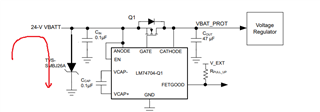Other Parts Discussed in Thread: TVS1800,
Tool/software:
Hi TI,
Why for 24V battery protection application 58V TVS diode is recommended?
Does not such diode have typical clamping voltage of over 90V which far exceeds LM74704 65V ANODE to GND limit?
What am I missing?
What nominal voltage is recommended for 100nF CCAP?
Kind regards,
Thomas




